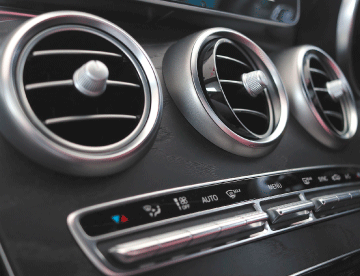Auto A/C repair shop in Florida.
Your Cars A/C System, and how it works.
Let me explain in layman’s terms how the air conditioning (AC) system works and what could be happening to your car. Like your body, the air conditioning compressor is the heart of the AC system, and Freon is the blood. The compressor pumps Freon throughout the AC system, either the older type R12 which costs as much as gold it seems these days, or the new environmentally-friendly R134A Freon. This Freon is a gas and liquid combination that is compressed and circulated throughout the air conditioning system. The compressed
Freon is pushed through the system under pressure and is passed through different sized metal and rubber hoses and a special valve called an expansion valve that cause the gas to expand and contract.
This expansion and contraction makes the Freon gas very cold. This cold gas makes its way via metal lines into the dash area of your vehicle to the evaporator core. This evaporator core is like a small radiator, except it has cold Freon circulating inside and not hot antifreeze. A small fan (the AC blower fan which you control from the control panel on the dash) sits in front of the evaporator core and blows air across this cold evaporator and then through the vents inside your vehicle.
The other objective of the air conditioning system is to remove the heat from inside the cab of the vehicle. This heat is removed by the Freon with the help of the AC condenser located at the front of the car (usually in front of the radiator). The Freon coming back from the evaporator carries the heat from the cab to the condenser via rubber and metal hoses. Just like your radiator, the condenser is lightweight aluminum with many internal winding coils. The Freon travels through these coils, and in between these coils are small slits or fins that the Freon is forced through. The condenser will have an electric cooling fan mounted in front or behind it to push or pull air through these fins to remove the heat from the Freon. Some vehicles still use the old fashioned fan blade driven by the engine to pull air across the radiator and the condenser.
Now I know that is just a tidbit of information on how the air conditioning system works, and it is very general, but I wanted you to know what to look for to give you insight as to what might be happening with your vehicle.
A few causes of low cooling efficiency or no cooling at all at idle are:
- Lack of air flow across the condenser. Make sure the electric cooling fan motor near the condenser is coming on, or in models that are equipped with a fan blade make sure this fan is turning and is turning very fast.
- Low Freon levels. Freon level and pressure should be checked by your certified air conditioning mechanic here at Value Tire and Alignment of Florida.
Overheating. If the engine is running hot or overheating, it can have a noticeable negative affect on the air conditioning system. Some cars have two electric cooling fans, one for the air conditioning condenser and the other for the radiator. Make sure they are both working properly. Usually at idle on a hot day with the AC on both fans will be on. When the vehicle is traveling at freeway speeds, the compressor is pumping the Freon throughout the system much faster and harder than at idle. There is a dramatic increase in air flow across the condenser due to 55 mph winds, and the engine is usually operating at a cooler, more efficient temperature as well, thus allowing the air conditioning system to operate efficiently.
Note: An air conditioning system that is somewhat low on Freon can still feel comfortable at freeway speeds due to the added air flow across the condenser which can overcome the ill effects of slightly low Freon. Periodic air conditioning performance checks by our certified mechanics here at Value Tire and Alignment is the best way to keep the system in great shape.
Come on down to Value Tire and Alignment for your NO COST NO OBLIGATION check on your cars air conditioning system.
